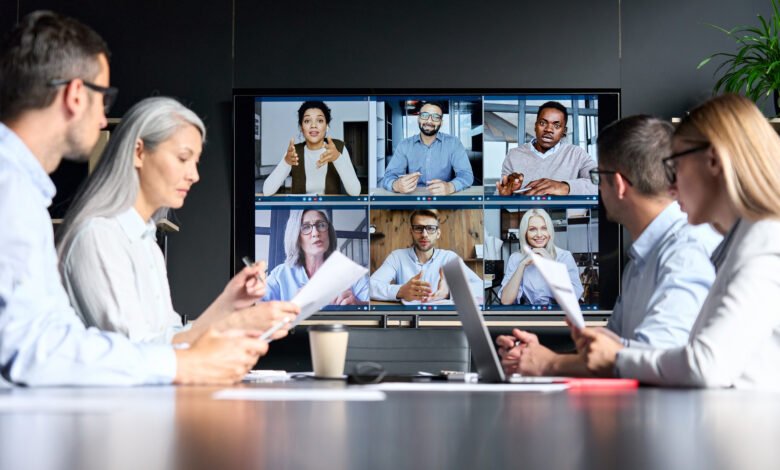The Work and Meeting Future in 2023

Over the past few years, there has been a tremendous amount of change in the working world. Even if many aspects of that transformation have been advantageous, such as lower costs for remote work and better work-life balance for employees, others, including meetings, now present new difficulties.
Organizational leaders need to look ahead in order to understand how they can conduct productive and interesting meetings in this new work environment as workforces become more hybrid or entirely remote.
Hybrid and Remote Are Here to Stay
The number of workers returning to the office in some capacity may increase in 2023, although this return is more likely to be a part of a hybrid work arrangement than a complete return to the conventional in-office schedule that was the norm before the epidemic.
Remote and hybrid working have become commonplace in the workplace and are likely to continue to do so as a result of the capacity to maintain productivity in a way that is less expensive for businesses and more convenient for employees.
Utilizing New Technology
In 2023, many organisational leaders seeking to improve collaboration and participation in their meetings are likely to start investigating new technology that has been developed with the contemporary workplace in mind.
While tools like Zoom have so far done a passable job of conducting meetings at remote or hybrid workplaces, they are not without their drawbacks. For instance, Zoom meetings have very little cooperation or contact, which can significantly lower participation.
With software like LiveShare and other digital collaboration tools tailored exclusively for B2B organisations and their specialised demands around team collaboration and sophisticated selling in a digital environment, Kaon Interactive aims to address those restrictions. Gavin Finn, CEO of Kaon, provided his perspective on the state of enterprise collaboration in 2023. These are his ideas on how to increase productivity in a distant setting.
Important Elements for Productive Team Collaboration Remotely
Over the past three years, it has been demonstrated across industries and disciplines that remote teams can be very productive. However, management teams have discovered that effective remote collaboration requires a multi-dimensional strategy. Collaboration is more than just technology. The three main components emphasise technology, process, and people.
Recognizing the unique qualities of various team members, as well as their time zone disparities, work schedule changes, and physical work environment, is essential from a people viewpoint. Some team members are comfortable working remotely using a technical collaboration platform. Others find it more difficult to move away from in-person cooperation, thus managers must take each team member’s unique learning and working preferences into account.
Processes typically involve both individual contribution aspects and concurrent, shared discussions and collaborations because a large portion of remote work occurs asynchronously, with some limited level of synchronous collaboration. To make the most of the time and to make sure that these sessions are designed to solve problems or advance when that real-time collaboration is most necessary, those moments when people are working and interacting with each other synchronously (i.e., all at once) must be scheduled and controlled. (As with face-to-face interactions, pointless meetings are annoying and ineffective.)
From a technological standpoint, one of the biggest mistakes managers make is believing that video (and audio) connections are the only thing needed for remote collaboration. Most remote collaborations require more than simply a video conferencing solution for the teams to be successful. They also require a separate collaborative workspace where team members can work both asynchronously and, crucially, during real-time collaboration meetings or sessions (e.g., an application or digital environment). The collaborative workspace should enable simultaneous, real-time multi-user interactions while enabling non-linear viewing, analysis, and modification of substantive content.
Collaboration requires that all remote team members take an active role in conversations, brainstorming sessions, and real-time meetings for teams to be genuinely productive. When everyone is engaged, their concentration is on working together as a team and they have the mental room to listen, understand, and contribute. The usage of video and/or audio channels as a sole means of communication has its drawbacks, thus they must be supplemented by digital environments that enable multi-user real-time collaboration.
When hybrid collaboration is done well, innovation results.
Hybrid collaboration can lead to imaginative and creative problem-solving synergy between all team members when properly planned and carried out. The development of relationships in person cannot be completely replaced, but hybrid collaboration can incorporate many of the skills required for teamwork and communication. The following trade-offs were considered when assessing these choices:
Access
How many team members could have physically attended if all meetings were held in person and how many would have been excluded due to travel limitations or other factors?
Cost
Would physically bringing individuals together cost more money? – transportation, hotel, food, etc.
Time
Would each participant spend significantly more time travelling to the actual meeting than merely the time spent in it if all the processes to get there were taken into consideration?
Effectiveness/Innovation/Creativity
When the team members are not physically present together, this can assist them still be as productive at coming up with new ideas, building on one another’s ideas, and spotting accidental or unforeseen possibilities for ideation.
Naturally, the responses differ, but it is evident that there are situations in which the variables might result in either outcome. It is entirely possible to create inventive and creative problem-solving or design sessions in a hybrid mode with the correct people, tools, and methods. It is also true that in-person meetings might produce superior results for some teams and certain situations.
Meetings & Technology Need to Be Designed for Remote Work
At the moment, video conferencing software is the mainstay of most online meetings. Although far more sophisticated than in earlier generations, the technology used in these sessions still has drawbacks and restrictions. Many meetings are devoted to repeating and clarifying oral talks or reconnecting when connections are lost since the audio and video quality is occasionally so bad (due, in certain circumstances, to the software itself, bandwidth issues, limitations of older computing devices, etc.).
In addition to the technology, remote meetings are not well-designed for collaboration; instead, they consist of a series of speakers (or even presenters utilising slides) and a passive audience. Due to the significant loss of focus and attention caused by this, relatively little information is retained after the meeting. In these encounters, where the video conference is taking place on the same computer as their email and social media, for example, the chance for distraction is dramatically expanded. People are naturally prone to being easily distracted.
For our business clients, we specifically created LiveShare for these reasons. It offers a virtual environment for collaboration that is immersive and engaging for every participant rather than passive, together with cutting-edge AV technology.
Leaders Must Engage Through Multiple Channels
Today’s leaders need to develop their multichannel audience engagement skills. Due to their outgoing personalities and capacity to establish connections through shaking hands, looking people in the eye, and other nonverbal cues, some leaders have been incredibly successful at fostering rapport with others. These abilities are less useful and more difficult to imitate in online media.
Effective leaders for hybrid collaboration give equal attention to each participant, learning how to interact with people and groups in ways that are appropriate for the channel and the individual. To create trust and lead hybrid teams, simple strategies like noting that not everyone is in the same physical location and including remote team members in the collaboration discussion are essential.
Getting Rid Of The Modern Problem Of Engaging In-Person And Remotely At The Same Time
Traditionally, the focus of sales meetings has been the sales team’s presentation to a potential customer. This has always been the case with in-person meetings, and it remained that way even after the epidemic forced most sales transactions to take place online. In either scenario, the underlying paradigm has been faulty because most prospects prefer communication and discourse over being provided with information. Prospects lose interest rapidly when passively listening to or viewing a sales presentation as a result, and as a result, memory retention suffers greatly.
Due to participants’ increased levels of distraction during video conference meetings, sales presentations delivered online (e.g., through video conference with screen sharing) are less effective than those delivered in person. Notifications from emails and social media posts arrive, and other work is practically available for completion. Focus and attention are lost as a result, and as a result, memory retention and comprehension of material in a slide presentation or video are even lower than the 20% for in-person meetings.
Read More: Top 10 Zoom Tips for Better Video Calls
Due to the multi-channel nature of the attendance, hybrid sales meetings struggle to keep everyone in the room focused and paying attention.
The answer to this problem is to involve everyone in the meeting, both digitally and utilising analogue methods for those present. Whiteboards, for instance, can be accessed by all users through the use of shared workspaces and serve as the focal point for discussions. Allowing participants to use collaborative interactive digital tools for communications and discoveries is another successful way to ensure that everyone is in the same “digital area” but that the discussion is still highly customised and non-linear. Imagine being on a museum tour; the guide may lead everyone through a particular exhibit where they all view the identical artefacts on display, but they each do so from a different perspective.
When combined with video and audio capabilities, these shared digital collaboration ways may be used both locally and remotely and are perfect for hybrid sales meetings. When opposed to conventional sales presentations, the new paradigm ensures that everyone is attentive, focused, and involved, which dramatically increases memory retention and comprehension.











